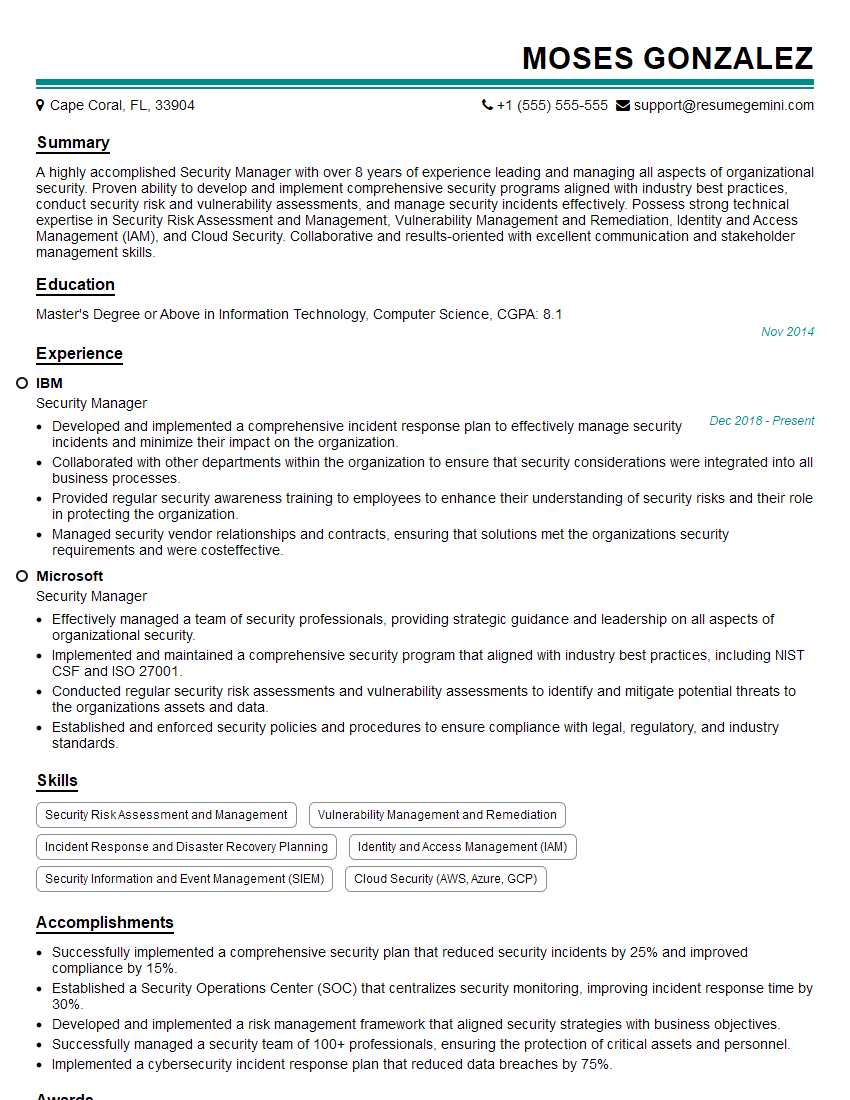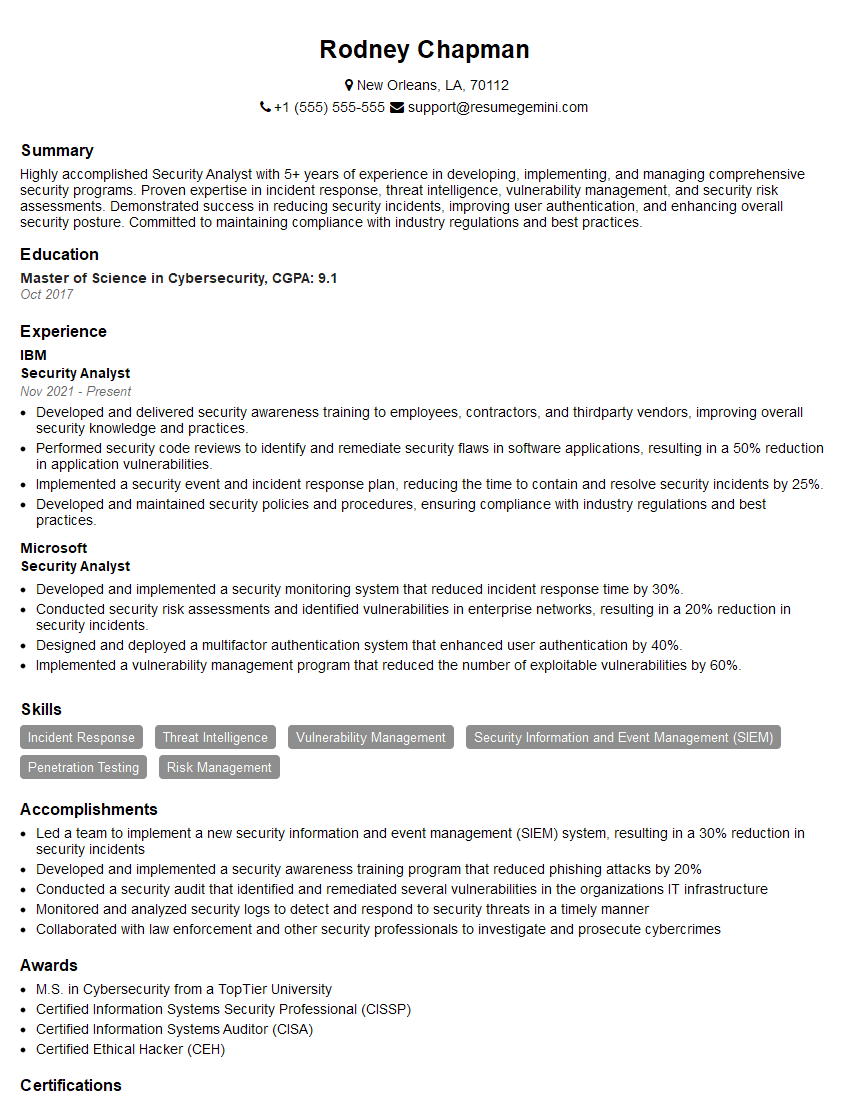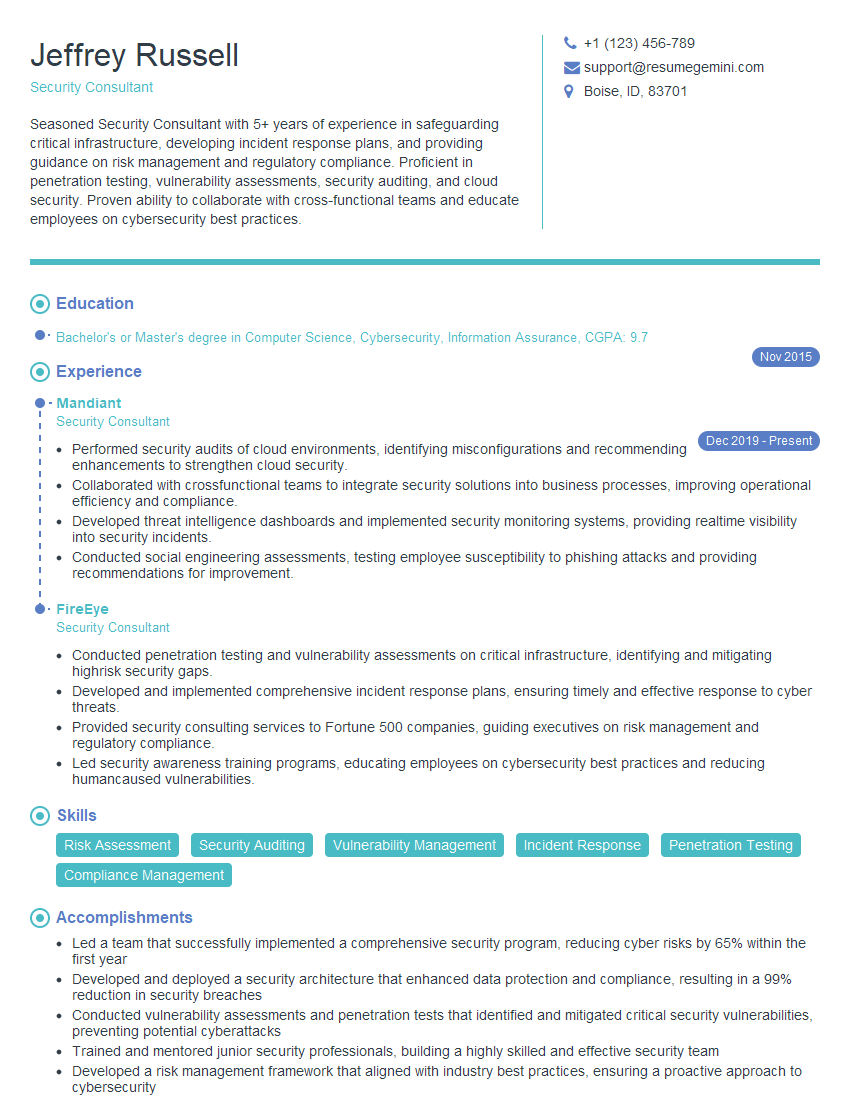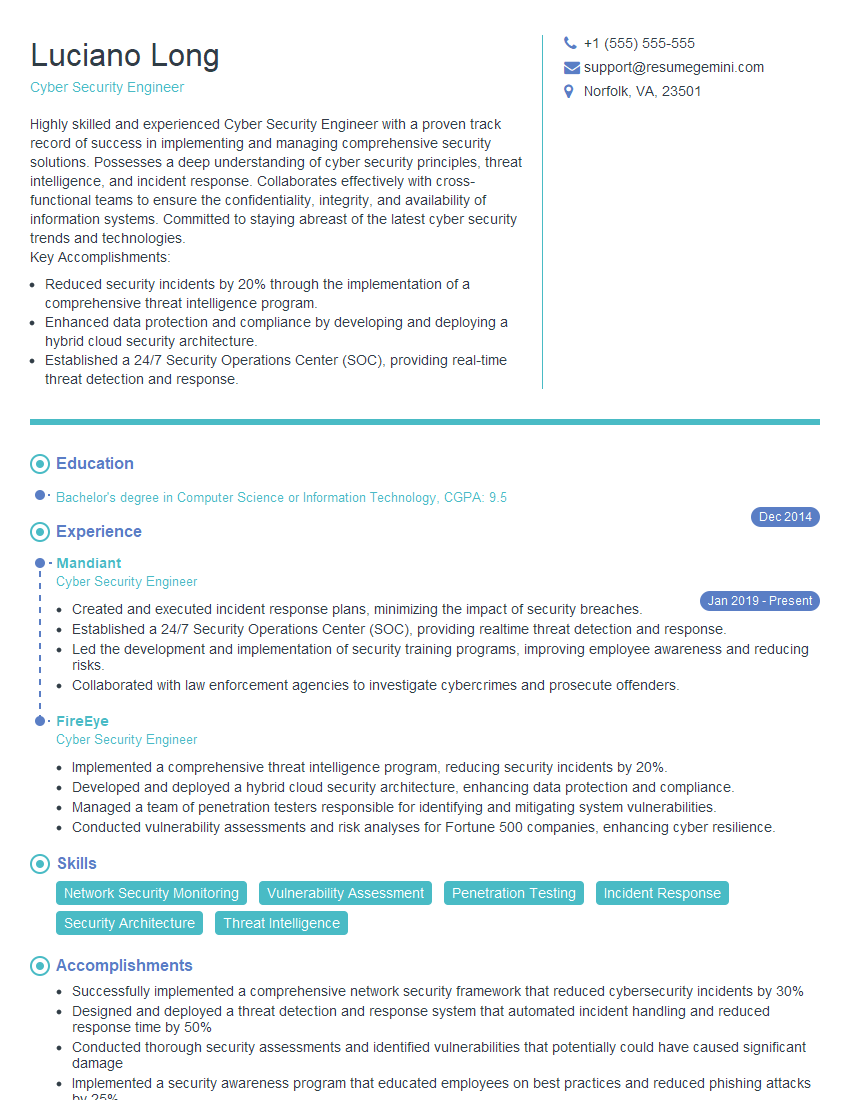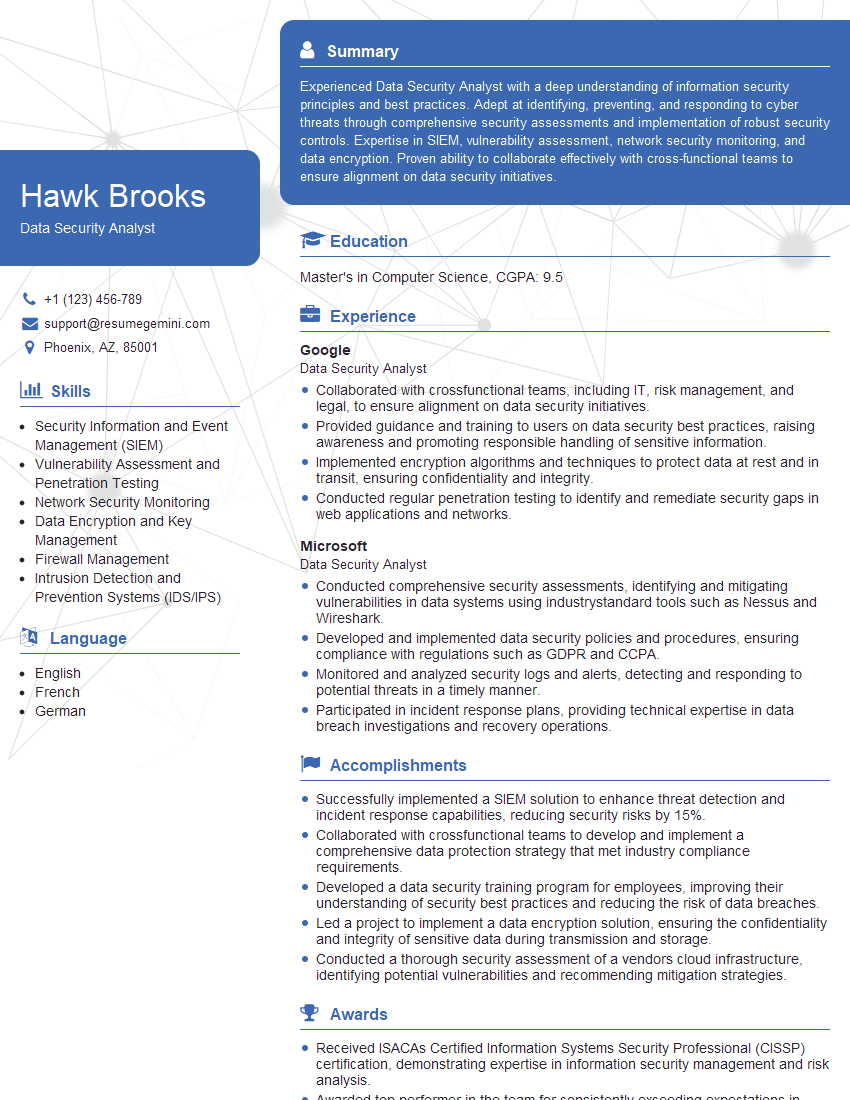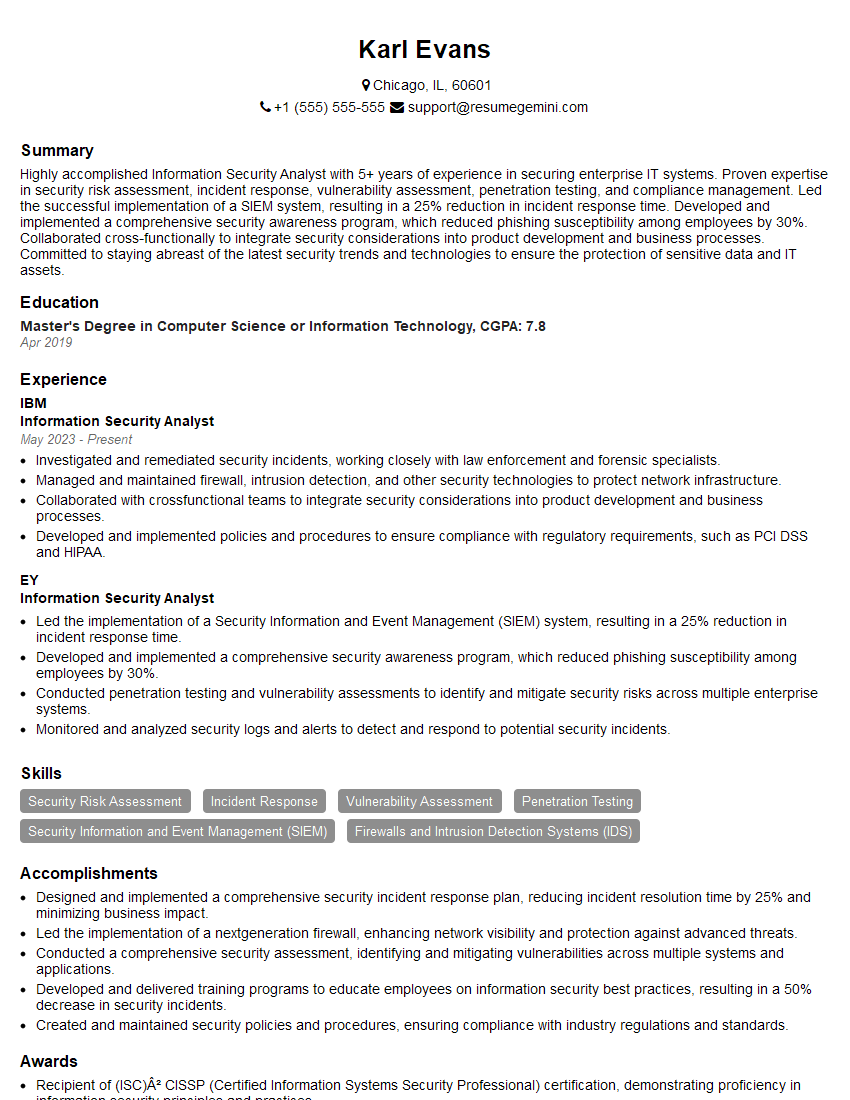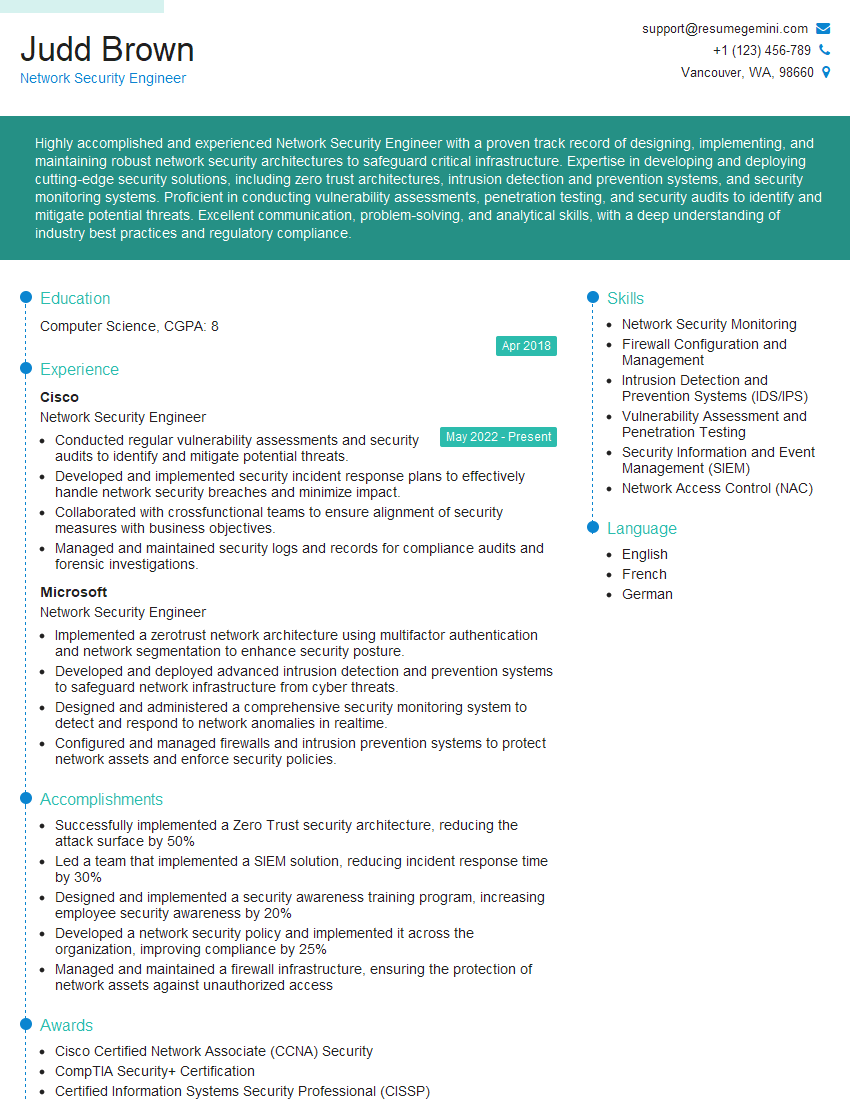Unlock your full potential by mastering the most common Cyber Threat Detection and Prevention interview questions. This blog offers a deep dive into the critical topics, ensuring you’re not only prepared to answer but to excel. With these insights, you’ll approach your interview with clarity and confidence.
Questions Asked in Cyber Threat Detection and Prevention Interview
Q 1. Explain the difference between signature-based and anomaly-based intrusion detection.
Signature-based and anomaly-based intrusion detection systems (IDS) represent two fundamentally different approaches to identifying malicious activity. Think of it like this: signature-based IDS is like searching for a specific criminal using a mugshot (known signature), while anomaly-based IDS is like noticing someone acting suspiciously (deviating from normal behavior).
Signature-based IDS relies on pre-defined patterns or signatures of known malicious activities, such as specific virus code or network attack patterns. When a system detects a match between the observed activity and a known signature in its database, it triggers an alert. This is highly effective against known threats but is ineffective against zero-day exploits or sophisticated attacks that don’t match any existing signature.
Anomaly-based IDS, on the other hand, establishes a baseline of normal system behavior. It continuously monitors system activity and flags deviations from this baseline as potential anomalies. These deviations could indicate malicious activity. This method is better at detecting unknown threats but can also generate a high number of false positives due to legitimate activities that might deviate from the established baseline. For example, a sudden surge in database queries could be a legitimate report generation process or a malicious data exfiltration attempt. Proper configuration and analysis are vital to minimizing these false positives.
In practice, a hybrid approach combining both signature-based and anomaly-based detection is often the most effective strategy, leveraging the strengths of both methods while mitigating their weaknesses.
Q 2. Describe the MITRE ATT&CK framework and its use in threat hunting.
The MITRE ATT&CK framework is a globally-accessible knowledge base of adversary tactics and techniques based on real-world observations. It’s essentially a catalog of common attack methods, organized into stages of an attack lifecycle (reconnaissance, resource development, etc.). Each technique is described with detailed information and often includes associated mitigations.
In threat hunting, MITRE ATT&CK serves as a crucial framework for identifying potential threats and weaknesses. Security analysts can use it to:
- Prioritize investigations: By focusing on techniques commonly used by threat actors, analysts can prioritize their efforts on the most likely attack vectors.
- Develop detection rules: The framework provides insights into the technical details of each attack technique, which can be used to create more effective security rules and alerts.
- Improve incident response: Understanding the tactics and techniques used in an attack can help speed up the incident response process and lead to a more effective remediation.
- Measure effectiveness: Organizations can use ATT&CK to assess the effectiveness of their security controls and identify gaps in their defenses.
For example, if an analyst suspects a compromise, they might start by reviewing ATT&CK techniques related to initial access and lateral movement. This focused approach, guided by the framework, increases the efficiency and effectiveness of the investigation significantly compared to a more generic approach.
Q 3. What are the key components of a Security Information and Event Management (SIEM) system?
A Security Information and Event Management (SIEM) system is the central nervous system of a modern security operation center (SOC). It collects, aggregates, analyzes, and correlates security logs from various sources across the organization. The key components are:
- Log collection and aggregation: This component gathers security logs from diverse sources like firewalls, intrusion detection systems, servers, and applications. It’s crucial that the system can ingest logs from various formats and sources.
- Data normalization and correlation: This involves transforming raw log data into a standardized format and then correlating events from different sources to identify patterns and relationships. This is where the real intelligence comes from – finding connections between seemingly unrelated events.
- Event analysis and alerting: This component analyzes the correlated events to identify potential security threats. Alerts are triggered based on predefined rules or machine learning models, notifying SOC analysts of suspicious activities.
- Reporting and dashboards: This provides valuable insights into the organization’s security posture, allowing security teams to track key metrics, identify trends, and effectively manage risks.
- Security Orchestration, Automation, and Response (SOAR): Modern SIEMs often incorporate SOAR capabilities, automating incident response tasks such as blocking malicious IPs or isolating compromised systems.
Think of a SIEM as a central hub receiving information from all corners of your network. By aggregating and analyzing this information, the SIEM helps identify and respond to threats effectively.
Q 4. How do you prioritize security alerts in a SOC environment?
Prioritizing security alerts in a SOC environment is a critical skill. A constant barrage of alerts can quickly overwhelm even the most experienced analysts, leading to alert fatigue and missed threats. Prioritization should be based on a combination of factors:
- Severity: High-severity alerts indicating critical systems compromise or data breaches should be prioritized immediately.
- Criticality of asset: Alerts affecting critical systems or sensitive data should be handled before those affecting less critical assets.
- Likelihood: The probability that the alert represents an actual threat, considering the source and the nature of the event.
- Remediation complexity: Alerts requiring complex and time-consuming remediation efforts may need to be prioritized based on their business impact.
- Alert volume: The sheer number of similar alerts may indicate a widespread attack, necessitating immediate attention.
Many SOCs use a scoring system that combines these factors to automatically assign priority levels to alerts, helping analysts focus on the most important issues first. An alert from a known malicious IP attempting access to a database server will, undoubtedly, have higher priority than an alert for a failed login attempt from an unknown but low-risk IP address.
Q 5. What are common indicators of compromise (IOCs)?
Indicators of Compromise (IOCs) are pieces of evidence that suggest a system or network has been compromised. They serve as clues in identifying and responding to security incidents. Common IOCs include:
- Malicious IP addresses: IP addresses known to be associated with malicious activity.
- Malicious domains: Domains used for command and control (C&C) servers or phishing campaigns.
- Hash values: Unique fingerprints of malware files, enabling detection of specific malware strains.
- URLs: Links to malicious websites or phishing pages.
- File paths: Locations of malicious files on a compromised system.
- Registry keys: Registry entries created by malware on Windows systems.
- Process IDs: Unique identifiers for running processes that may indicate malicious activity.
- Network traffic patterns: Unusual network activity, such as high volumes of outbound connections or communication with known malicious servers.
These IOCs can be used to identify potential threats, track attacker activity, and take appropriate remediation actions. For example, identifying a malicious IP address might prompt blocking it at the firewall level.
Q 6. Explain the process of incident response, from detection to recovery.
Incident response is a structured process for handling security incidents, from initial detection to full recovery. The process typically involves these stages:
- Preparation: This involves establishing incident response plans, defining roles and responsibilities, and ensuring that necessary tools and resources are in place. This is crucial, as a well-defined plan allows for quicker and more effective responses to incidents.
- Detection and Analysis: This involves identifying the incident, gathering evidence, and determining the scope and impact of the breach. Log analysis, security monitoring tools, and threat intelligence are critical here.
- Containment: This involves isolating the affected systems or networks to prevent further damage or data loss. This might involve disconnecting affected systems from the network or blocking malicious traffic.
- Eradication: This involves removing the malware or threat and restoring the affected systems to a secure state. This might involve reinstalling operating systems, removing malicious files, and patching vulnerabilities.
- Recovery: This involves restoring systems to their normal operating state and verifying that all data has been restored and secured. This might involve restoring backups and conducting rigorous testing.
- Post-Incident Activity: This involves reviewing the incident, identifying lessons learned, and updating security controls to prevent similar incidents in the future. Post-incident reports are vital for understanding and improving future responses.
Each stage is critical, and a failure in any stage can significantly impact the overall effectiveness of the incident response. A successful response relies on a well-coordinated team, clear communication, and a solid understanding of the attack lifecycle.
Q 7. Describe your experience with various threat intelligence platforms.
Throughout my career, I’ve had extensive experience with various threat intelligence platforms, both commercial and open-source. I’m proficient in using platforms like ThreatConnect, MISP (Malware Information Sharing Platform), and Recorded Future. These platforms differ in their data sources, analysis capabilities, and integration options.
For example, ThreatConnect offers excellent collaboration and workflow capabilities, making it particularly useful for teams. MISP excels in open-source intelligence sharing and is ideal for collaborative threat hunting. Recorded Future, on the other hand, provides a more comprehensive and commercially-driven approach with advanced analytics and prediction capabilities. My experience with these platforms has enabled me to effectively gather and analyze threat intelligence, identify emerging threats, and improve our organization’s overall security posture. I’ve used this intelligence to enrich our detection rules, better prioritize alerts, and develop more effective incident response strategies. The use of these platforms significantly improves our ability to proactively identify and respond to evolving threats.
Q 8. How do you stay up-to-date with the latest cyber threats and vulnerabilities?
Staying ahead in cybersecurity requires a multi-faceted approach. Think of it like being a doctor – you need to constantly update your knowledge on new diseases (threats) and treatments (defensive strategies). I leverage several key methods:
Threat Intelligence Feeds: I subscribe to reputable threat intelligence platforms that provide real-time alerts on emerging threats, vulnerabilities, and malware campaigns. These feeds often include indicators of compromise (IOCs) that I can use to proactively monitor my systems.
Security Research and Publications: I regularly read industry publications, research papers, and blog posts from leading security experts and researchers. This helps me understand the latest attack techniques and the vulnerabilities being exploited.
Security Conferences and Webinars: Attending industry conferences and webinars offers invaluable insights into the latest threats and best practices. Networking with other professionals is also crucial for staying informed.
Vulnerability Databases: I actively monitor vulnerability databases like the National Vulnerability Database (NVD) to stay updated on newly discovered vulnerabilities in software and hardware. This allows me to prioritize patching efforts.
Hands-on Experience: I regularly practice my skills through capture-the-flag (CTF) competitions and simulated attack scenarios. This practical experience helps solidify my understanding of attack methodologies and defensive countermeasures.
Q 9. Explain the concept of a kill chain and how it’s used in threat analysis.
The kill chain is a model that describes the stages of a cyberattack, from initial reconnaissance to the final objective. Think of it as a roadmap for an attacker. Understanding this roadmap allows defenders to identify vulnerabilities and disrupt the attack at various points. The stages typically include:
Reconnaissance: The attacker gathers information about the target.
Weaponization: The attacker develops a malicious payload.
Delivery: The attacker delivers the payload to the target (e.g., phishing email).
Exploitation: The attacker exploits a vulnerability to gain access.
Installation: The attacker installs malware on the target system.
Command and Control: The attacker establishes communication with the compromised system.
Actions on Objectives: The attacker achieves their goal (e.g., data exfiltration).
Threat analysis using the kill chain helps identify weak points in the defense. For example, if we notice a high number of exploitation attempts targeting a specific vulnerability, we know we need to prioritize patching that vulnerability. By understanding where attacks typically fail, we can strengthen those points in our defenses.
Q 10. What are some common malware families and their characteristics?
Malware families are groups of malicious software sharing similar characteristics or code. Some common examples include:
Ransomware: Encrypts data and demands a ransom for its release (e.g., Ryuk, WannaCry). Characterized by data encryption and ransom demands.
Trojans: Disguised as legitimate software but secretly performs malicious actions (e.g., Emotet). Often used to install other malware or provide backdoor access.
Worms: Self-replicating programs that spread across networks (e.g., Conficker). Characterized by self-propagation and network-based spread.
Viruses: Attach to other files and spread when those files are executed (less prevalent now). Characterized by their attachment to host files.
Spyware: Secretly monitors user activity and collects sensitive information (e.g., keyloggers). Characterized by covert data collection.
Rootkits: Conceal their presence and provide persistent access to a system (e.g., TDL-4). Characterized by stealth and persistence.
Understanding the characteristics of these families helps us develop appropriate detection and prevention strategies. For example, detecting unusual encryption activity is a key indicator of ransomware, while unusual network connections might point to a worm or botnet activity.
Q 11. How do you perform vulnerability assessments and penetration testing?
Vulnerability assessments and penetration testing are crucial for identifying security weaknesses. A vulnerability assessment is like a medical checkup – it scans for potential problems. Penetration testing is more like a stress test – it actively tries to exploit vulnerabilities to see how they behave.
Vulnerability Assessment: This involves using automated tools to scan systems and applications for known vulnerabilities. I use tools like Nessus, OpenVAS, and QualysGuard to identify vulnerabilities based on known exploits and misconfigurations. The results highlight potential weaknesses and their severity.
Penetration Testing: This involves simulating real-world attacks to identify exploitable vulnerabilities. Penetration testing is often categorized by scope (black box, white box, gray box) and methodology (ethical hacking). I follow a structured approach, typically involving reconnaissance, vulnerability scanning, exploitation, privilege escalation, and reporting.
Example: In a recent penetration test, we discovered a vulnerable web server due to outdated software. This vulnerability assessment allowed the client to patch the flaw and prevent attackers from gaining access.
Q 12. Describe your experience with network security protocols (e.g., TCP/IP, UDP).
Network security protocols like TCP/IP and UDP are fundamental to understanding and securing networks. TCP/IP (Transmission Control Protocol/Internet Protocol) provides reliable, ordered data transmission. Think of it like sending a registered letter – you get confirmation of delivery and the order is guaranteed. UDP (User Datagram Protocol) is a connectionless protocol that offers speed but lacks reliability. It’s like sending a postcard – faster, but there’s no guarantee of arrival or order.
My experience encompasses analyzing network traffic using tools like Wireshark to identify suspicious activity. I understand how these protocols are used in various network services (e.g., HTTP, HTTPS, DNS) and how vulnerabilities in their implementation can be exploited. For example, I’ve investigated network intrusions where attackers exploited TCP weaknesses to perform port scanning and gain unauthorized access.
Q 13. What are the different types of firewalls and their functionalities?
Firewalls are essential security devices that control network traffic based on predefined rules. Different types exist, each with its own functionalities:
Packet Filtering Firewalls: These inspect individual packets based on headers (source/destination IP, ports, protocols). They’re fast but less sophisticated. Think of it as a bouncer checking IDs at the door.
Stateful Inspection Firewalls: These track the state of network connections, allowing only expected return traffic. This enhances security by preventing unauthorized inbound connections. It’s like a bouncer who remembers who they let in.
Application-Level Firewalls (Proxy Firewalls): These inspect the data payload of network traffic, providing deeper inspection. They are slower but offer more granular control. Think of it as a more thorough security check, not just an ID check.
Next-Generation Firewalls (NGFWs): These combine features of previous firewall types, often adding advanced functionalities like intrusion prevention systems (IPS) and malware scanning capabilities. They provide a comprehensive security layer.
The choice of firewall depends on the specific security needs and budget. For example, a small business might use a basic packet filtering firewall, while a large enterprise would require a more advanced NGFW.
Q 14. Explain the importance of security logging and monitoring.
Security logging and monitoring are crucial for detecting and responding to security incidents. Think of it as a security camera system for your network. Logs record events, providing a historical record of activities. Monitoring involves actively analyzing these logs to detect anomalies and suspicious behaviors.
Effective security logging provides a detailed audit trail, allowing for incident reconstruction and forensic analysis. Monitoring tools alert us to potential threats in real-time, enabling timely responses. Examples include intrusion detection systems (IDS), security information and event management (SIEM) systems, and log management tools. Without logging and monitoring, detecting breaches would be extremely difficult, if not impossible. In a recent incident, our SIEM system detected a suspicious login attempt, leading to the immediate blocking of the account and prevention of a larger compromise.
Q 15. How do you analyze security logs to identify potential threats?
Analyzing security logs for potential threats involves a multi-step process that combines automated tools and human expertise. Think of it like being a detective investigating a crime scene – you need to meticulously examine the evidence to find clues.
First, I’d focus on log normalization and correlation. This means transforming logs from different sources into a standardized format and then identifying relationships between events. For example, a failed login attempt from an unusual location followed by a data exfiltration attempt would raise a significant red flag. I’d use tools like Elasticsearch, Logstash, and Kibana (ELK stack) to achieve this.
Next, I apply heuristics and anomaly detection. This is where I look for unusual patterns or behaviors that deviate from established baselines. Imagine a server suddenly sending out a massive volume of network traffic – that’s an anomaly warranting immediate investigation. Machine learning algorithms are invaluable in this process. Statistical analysis such as calculating standard deviations of various metrics helps pinpoint anomalies.
Security Information and Event Management (SIEM) systems are crucial here. They aggregate logs, apply pre-defined rules and heuristics, and alert on suspicious activity. I would then investigate alerts, validate the findings, and determine the severity of the threat.
Finally, regular review of security logs is essential for preventative maintenance. Identifying trends and patterns early can help in proactively addressing vulnerabilities before they are exploited.
Career Expert Tips:
- Ace those interviews! Prepare effectively by reviewing the Top 50 Most Common Interview Questions on ResumeGemini.
- Navigate your job search with confidence! Explore a wide range of Career Tips on ResumeGemini. Learn about common challenges and recommendations to overcome them.
- Craft the perfect resume! Master the Art of Resume Writing with ResumeGemini’s guide. Showcase your unique qualifications and achievements effectively.
- Don’t miss out on holiday savings! Build your dream resume with ResumeGemini’s ATS optimized templates.
Q 16. Describe your experience with various security tools (e.g., Snort, Wireshark).
I have extensive experience with various security tools, including Snort and Wireshark. They’re like different tools in a mechanic’s toolbox, each with its unique purpose.
Snort is an incredibly powerful intrusion detection system (IDS). I’ve used it extensively to monitor network traffic for malicious activity, such as port scans, malware signatures, and known attack patterns. For instance, I’ve configured Snort to alert on specific signatures related to SQL injection attempts or common malware signatures. Think of it as a security guard constantly scanning for suspicious behavior.
Example Snort rule: alert tcp any any -> any 21 (msg: "FTP port scan"; sid:1000001;)Wireshark is a network protocol analyzer; it’s my go-to tool for deep packet inspection. It allows me to analyze network traffic in detail, identifying the source, destination, and content of each packet. This is essential for investigating security incidents and understanding the full scope of an attack. For example, if I get a Snort alert suggesting a potential data exfiltration, I would use Wireshark to meticulously examine the network packets involved to see exactly what data was transferred and where it went.
In one instance, I used Wireshark to pinpoint the exact moment a specific malware infected a system. By closely analyzing the network traffic before and after the infection, I was able to identify the infection vector and contain the threat effectively.
Q 17. What are the key principles of data loss prevention (DLP)?
Data Loss Prevention (DLP) focuses on preventing sensitive data from leaving the organization’s control. Imagine it as a high-security vault protecting your most valuable assets.
The key principles of DLP are:
- Data Identification and Classification: This is the first step – figuring out what data needs protection. This involves identifying sensitive data like credit card numbers, personally identifiable information (PII), and intellectual property.
- Data Monitoring and Control: This involves implementing tools to monitor data movement across the network and enforce access controls. This could involve restricting access based on user roles and location.
- Data Protection Mechanisms: These include encryption (both at rest and in transit), access control lists (ACLs), and data masking to protect sensitive data from unauthorized access.
- Incident Response: This involves having a plan to respond to data breaches or leaks. This should include procedures for containing the breach, notifying affected parties, and conducting post-incident analysis.
- Policy Enforcement: Clear data handling policies and procedures must be established and enforced to ensure everyone understands their responsibilities.
An example of DLP in practice would be implementing a solution that scans emails for sensitive data before they’re sent. If it detects a credit card number, it will either block the email or prompt the user to encrypt it.
Q 18. How do you handle phishing attempts and social engineering attacks?
Handling phishing and social engineering attacks requires a multi-layered approach – both technical and human. It’s like building a fortress with multiple layers of defense.
Technical Measures include implementing email filters, anti-phishing software, and security awareness training. This helps prevent malicious emails from reaching users’ inboxes in the first place. Advanced tools can detect and block phishing attempts based on URL analysis, email header analysis and other techniques.
Human Measures are just as critical. Regular security awareness training educates users about the tactics used in phishing and social engineering attacks. This includes simulated phishing attacks and regular awareness campaigns. I’d also encourage users to report suspicious emails or websites immediately.
When a phishing attempt is detected, the immediate response involves isolating the affected systems and investigating the scope of the compromise. This often involves analyzing logs, checking for malware, and resetting passwords.
A successful defense involves a robust security awareness training program coupled with technical solutions. In one case, I trained employees to identify subtle cues in emails, such as inconsistencies in email addresses or unusually urgent requests, significantly reducing the success rate of phishing attempts.
Q 19. Explain the concept of zero-trust security.
Zero-trust security is a security model that assumes no implicit trust granted to any user, device, or network segment, regardless of location (inside or outside the organization’s network perimeter). It’s a shift from the traditional castle-and-moat approach to a more granular, risk-based security model.
The core principles of zero trust are:
- Least Privilege: Users and devices are only granted access to the resources they absolutely need, and nothing more. Think of it as needing a specific key to unlock only the specific drawers in a cabinet.
- Microsegmentation: The network is divided into smaller, isolated segments. This limits the impact of a breach by preventing attackers from freely moving laterally across the network.
- Continuous Verification: Users, devices, and applications are continuously verified and authenticated. This ensures that even if a user gains initial access, their privileges can be revoked immediately if their credentials or device are compromised.
- Data Encryption: Data is encrypted both at rest and in transit to protect sensitive information, regardless of its location.
- Centralized Policy Enforcement: Security policies are centrally managed and enforced to ensure consistency across the organization.
Zero Trust significantly reduces the attack surface and improves the overall security posture by treating every access attempt as a potential threat. It’s a more proactive and resilient approach to security than the traditional perimeter-based models.
Q 20. What are your experiences with cloud security solutions (e.g., AWS, Azure, GCP)?
I possess significant experience with cloud security solutions from major providers like AWS, Azure, and GCP. Each cloud provider offers a unique set of security services, but the underlying principles remain the same. Think of them as different flavors of the same fundamental security concepts.
In AWS, I have extensive experience working with services like IAM (Identity and Access Management), GuardDuty (threat detection service), and KMS (Key Management Service) for securing data and applications. For instance, I utilized IAM roles and policies to minimize privilege escalation risks.
In Azure, I’ve worked with Azure Security Center for centralized security management, Azure Active Directory for identity management, and Azure Key Vault for managing encryption keys. I implemented Azure’s security best practices to enhance the security posture of various applications and infrastructure components.
With GCP, my experience includes using Cloud IAM, Cloud Security Command Center, and Cloud Data Loss Prevention (DLP) APIs to manage and secure data and access. This includes configuring access controls and logging to ensure compliance and auditability.
My experience spans across securing different cloud workloads, including virtual machines, databases, and serverless functions. A successful deployment strategy includes comprehensive risk assessment and the implementation of security best practices for each cloud environment.
Q 21. Describe your experience with different authentication and authorization methods.
Authentication and authorization are fundamental security mechanisms. Authentication verifies *who* you are, while authorization determines *what* you’re allowed to do. It’s like having a keycard to enter a building (authentication) and then only being able to access certain floors or rooms (authorization).
I have experience with a variety of methods:
- Password-based authentication: This is the most common method, but it’s prone to vulnerabilities if passwords are weak or reused. Multi-factor authentication (MFA) significantly enhances its security.
- Multi-factor authentication (MFA): This adds an extra layer of security by requiring multiple forms of authentication, such as a password and a one-time code from a mobile app. This greatly reduces the risk of unauthorized access.
- Biometric authentication: Methods like fingerprint or facial recognition offer strong authentication but raise privacy concerns that need careful consideration.
- Token-based authentication: This method uses tokens (short-lived digital keys) to authenticate users and authorize access. This method is widely used in APIs and microservices and offers a more secure alternative to password-based authentication.
- Role-Based Access Control (RBAC): This allows granular control over user access based on their roles within the organization. This helps ensure that users only have access to the resources necessary for their job.
- Attribute-Based Access Control (ABAC): This is a more sophisticated method that allows access control decisions to be based on various attributes, including user roles, time of day, location, and data sensitivity.
Choosing the right authentication and authorization methods depends on the specific security requirements and risk tolerance. In many cases, a layered approach using multiple methods is recommended.
Q 22. How do you ensure compliance with industry security standards (e.g., ISO 27001, NIST)?
Ensuring compliance with industry security standards like ISO 27001 and NIST frameworks is crucial for maintaining a robust security posture. It’s not just about ticking boxes; it’s about embedding security into the fabric of the organization. My approach involves a multi-faceted strategy:
- Gap Analysis: We begin by conducting a thorough gap analysis, comparing our existing security controls against the specific requirements of the chosen standard (e.g., ISO 27001 Annex A controls or NIST Cybersecurity Framework functions). This identifies areas needing improvement.
- Policy & Procedure Development: Based on the gap analysis, we develop or update relevant policies and procedures to align with the standard’s requirements. This includes access control policies, incident response plans, data backup procedures, and more. For instance, if ISO 27001 requires regular vulnerability scans, we’d document this process in a clear procedure.
- Implementation & Monitoring: We implement the defined controls, using tools and technologies to support them. This could involve deploying firewalls, intrusion detection systems (IDS), and security information and event management (SIEM) systems. Regular monitoring and auditing are essential to ensure continued compliance. We use dashboards and reports to track key metrics and identify any deviations.
- Regular Audits & Reviews: Periodic internal and external audits are conducted to validate our compliance. This involves reviewing documentation, testing controls, and assessing overall effectiveness. Corrective actions are implemented to address any identified non-compliances.
- Continuous Improvement: Compliance is not a one-time event; it’s an ongoing process. We use the audit findings and other feedback to continuously improve our security posture and maintain compliance.
For example, meeting the ISO 27001 requirement for asset management involves not only identifying all critical assets but also implementing procedures for regular review and updates of that asset register. This ensures that we remain aware of our critical systems and maintain appropriate security controls.
Q 23. Explain the difference between preventative and detective security controls.
Preventative and detective security controls are two sides of the same coin, both vital for a robust security strategy. Think of them as proactive defense and reactive investigation.
- Preventative Controls: These controls aim to stop security incidents before they occur. They act as barriers, preventing unauthorized access or malicious activity. Examples include firewalls (blocking unauthorized network traffic), intrusion prevention systems (IPS – actively blocking malicious traffic), access control lists (ACLs – restricting access based on permissions), and strong passwords/multi-factor authentication (MFA – preventing unauthorized logins).
- Detective Controls: These controls focus on identifying security incidents after they’ve occurred. They help detect breaches and understand their impact. Examples include intrusion detection systems (IDS – passively monitoring network traffic for suspicious activity), security information and event management (SIEM) systems (collecting and analyzing security logs from various sources), log analysis, and security audits.
A strong security strategy employs both types of controls in a layered approach. For instance, a firewall (preventative) might stop most attacks, but a SIEM (detective) would capture and alert on any that get through. Think of a castle: preventative controls are the walls, moats, and gates, while detective controls are the guards and surveillance systems.
Q 24. How do you develop and implement security awareness training programs?
Developing and implementing effective security awareness training is paramount. It’s about changing behaviours and fostering a security-conscious culture. My approach involves:
- Needs Assessment: We start by assessing the organization’s specific security risks and the employees’ current knowledge level. This helps tailor the training to address actual needs.
- Engaging Content: Training materials should be interactive, engaging, and relevant. We avoid lengthy lectures and use scenarios, simulations, quizzes, and gamification to enhance learning and retention. This includes addressing phishing scams, social engineering, and safe browsing habits.
- Regular and Targeted Training: Security awareness isn’t a one-time event. We schedule regular training sessions, focusing on emerging threats and vulnerabilities. We also conduct targeted training for specific roles with higher security responsibilities, such as system administrators.
- Practical Exercises: We include hands-on exercises, like simulated phishing attacks, to test employees’ responses and reinforce training. This helps employees develop critical thinking skills to identify threats.
- Metrics and Measurement: We track the effectiveness of training programs by measuring employee knowledge and behaviour changes through assessments, phishing simulations, and incident reports. This data helps improve the program over time.
For example, we might use realistic phishing emails as part of training, and later track how many employees fell for similar attacks in the real world. This allows for adjusting training to better address specific vulnerabilities.
Q 25. Describe a time you had to respond to a significant security incident.
During my time at [Previous Company Name], we experienced a significant ransomware attack. A compromised employee’s credentials allowed attackers to encrypt critical server data. Our response followed a structured incident response plan:
- Containment: We immediately isolated the affected servers to prevent further spread of the ransomware. This involved disconnecting them from the network.
- Eradication: We deployed updated antivirus software and ran full system scans to identify and remove the malware.
- Recovery: We restored data from our backups. This highlighted the importance of regular, tested backups.
- Analysis: We conducted a thorough forensic investigation to determine the root cause of the breach and identify vulnerabilities. This showed that the employee had fallen for a phishing email.
- Lessons Learned: We updated our security awareness training to emphasize phishing detection techniques. We also strengthened our access control measures and improved our backup procedures.
The incident reinforced the importance of a well-defined incident response plan, regular backups, and comprehensive security awareness training. It also highlighted the need for continuous improvement in our security posture.
Q 26. How do you contribute to the development of a security strategy?
Contributing to the development of a security strategy requires a holistic understanding of the organization’s risks and objectives. My contribution involves:
- Risk Assessment: I participate in identifying and analyzing potential threats and vulnerabilities. This includes assessing the likelihood and impact of different threats, such as data breaches, malware infections, and denial-of-service attacks.
- Control Selection: I help choose and implement appropriate security controls to mitigate identified risks. This includes considering both preventative and detective controls, as well as technical, administrative, and physical safeguards.
- Budget & Resource Allocation: I assist in developing a budget and allocating resources to support the implementation and maintenance of security controls. This involves justifying the costs associated with security investments.
- Compliance Requirements: I ensure the security strategy aligns with relevant industry standards and regulations, such as ISO 27001, NIST Cybersecurity Framework, and GDPR.
- Communication & Collaboration: I work closely with other teams, such as IT, operations, and legal, to develop and implement a comprehensive security strategy. This includes educating stakeholders about security risks and best practices.
For example, I’d advocate for multi-factor authentication based on a risk assessment that shows a high likelihood of credential compromise through phishing attacks. This combines risk assessment with control selection in a practical way.
Q 27. What is your approach to identifying and mitigating insider threats?
Identifying and mitigating insider threats requires a multi-layered approach. It’s about understanding the human element of security.
- Access Control: Implementing the principle of least privilege ensures employees only have access to the information and systems necessary for their roles. This minimizes the potential damage from a malicious or negligent insider.
- Monitoring & Auditing: Regularly monitoring user activity, access logs, and system events helps detect anomalous behaviour. This could include unusual data access patterns or attempts to bypass security controls.
- Data Loss Prevention (DLP): Employing DLP tools monitors data movement to identify sensitive data leaving the organization without authorization.
- Security Awareness Training: Training employees on security policies and procedures, emphasizing the importance of data security and responsible behaviour, is essential.
- Background Checks & Vetting: Conducting thorough background checks for employees in sensitive positions can help identify potential risks.
- Data Encryption: Encrypting sensitive data, both at rest and in transit, protects it even if it falls into the wrong hands.
For example, monitoring user login attempts could reveal an employee trying to access systems outside their normal working hours. This could be a red flag to investigate further. A combination of monitoring, access control, and training is key to mitigate the insider threat risk effectively.
Q 28. Explain your understanding of blockchain security and its vulnerabilities.
Blockchain technology, while offering enhanced security in some aspects, isn’t impervious to vulnerabilities. My understanding encompasses both its strengths and weaknesses:
- Strengths: Blockchain’s decentralized and immutable nature makes it difficult to alter or tamper with data. The cryptographic hashing and consensus mechanisms provide strong data integrity and authenticity.
- Weaknesses:
- 51% Attacks: In some blockchain architectures, an attacker controlling more than 50% of the network’s computing power could potentially manipulate the blockchain. This is less of a concern in large, well-established blockchains like Bitcoin.
- Smart Contract Vulnerabilities: Smart contracts, which automate transactions on the blockchain, can contain vulnerabilities that could be exploited by attackers. Poorly written smart contracts can lead to significant financial losses.
- Private Key Management: The security of a blockchain user’s assets relies heavily on the security of their private keys. Loss or compromise of private keys can result in the loss of funds.
- Oracle Manipulation: Oracles, which feed external data into smart contracts, can be manipulated to compromise the integrity of the smart contract’s logic.
- Sybil Attacks: These attacks involve creating multiple fake identities (Sybils) to influence consensus mechanisms or gain undue influence in the network.
Therefore, while blockchain technology provides inherent security features, vulnerabilities arise mainly from the implementation of its applications and the management of its associated keys and contracts. Robust coding practices, rigorous auditing, and secure key management are crucial for mitigating these risks.
Key Topics to Learn for Cyber Threat Detection and Prevention Interview
- Threat Modeling and Risk Assessment: Understanding common attack vectors, vulnerabilities, and potential impact on organizational assets. Practical application: Conducting a threat modeling exercise for a hypothetical system.
- Security Information and Event Management (SIEM): Knowledge of SIEM tools and their role in collecting, analyzing, and correlating security logs. Practical application: Describing how to use SIEM alerts to investigate and respond to security incidents.
- Intrusion Detection and Prevention Systems (IDS/IPS): Understanding the functionality, deployment, and limitations of IDS/IPS technologies. Practical application: Explaining the differences between signature-based and anomaly-based detection methods.
- Network Security Monitoring: Analyzing network traffic for malicious activity using tools like tcpdump or Wireshark. Practical application: Identifying suspicious network connections and explaining your analysis process.
- Endpoint Detection and Response (EDR): Understanding the capabilities of EDR solutions in detecting and responding to threats on individual endpoints. Practical application: Describing how to investigate a suspected malware infection using EDR tools.
- Security Orchestration, Automation, and Response (SOAR): Knowledge of SOAR platforms and their role in automating security processes. Practical application: Explaining how SOAR can improve incident response efficiency.
- Vulnerability Management: Understanding vulnerability scanning, assessment, and remediation processes. Practical application: Describing a vulnerability management lifecycle and best practices.
- Incident Response and Forensics: Knowledge of incident response methodologies and digital forensics techniques. Practical application: Outlining steps to take during a security incident investigation.
- Cloud Security: Understanding security challenges and best practices in cloud environments (e.g., AWS, Azure, GCP). Practical application: Describing security considerations when migrating applications to the cloud.
Next Steps
Mastering Cyber Threat Detection and Prevention is crucial for a thriving career in cybersecurity, opening doors to high-demand roles with excellent growth potential. To maximize your job prospects, focus on creating a compelling and ATS-friendly resume that showcases your skills and experience effectively. ResumeGemini is a trusted resource to help you build a professional and impactful resume, significantly improving your chances of landing your dream job. Examples of resumes tailored to Cyber Threat Detection and Prevention are available to help guide your resume building process.
Explore more articles
Users Rating of Our Blogs
Share Your Experience
We value your feedback! Please rate our content and share your thoughts (optional).
What Readers Say About Our Blog
These apartments are so amazing, posting them online would break the algorithm.
https://bit.ly/Lovely2BedsApartmentHudsonYards
Reach out at [email protected] and let’s get started!
Take a look at this stunning 2-bedroom apartment perfectly situated NYC’s coveted Hudson Yards!
https://bit.ly/Lovely2BedsApartmentHudsonYards
Live Rent Free!
https://bit.ly/LiveRentFREE
Interesting Article, I liked the depth of knowledge you’ve shared.
Helpful, thanks for sharing.
Hi, I represent a social media marketing agency and liked your blog
Hi, I represent an SEO company that specialises in getting you AI citations and higher rankings on Google. I’d like to offer you a 100% free SEO audit for your website. Would you be interested?

